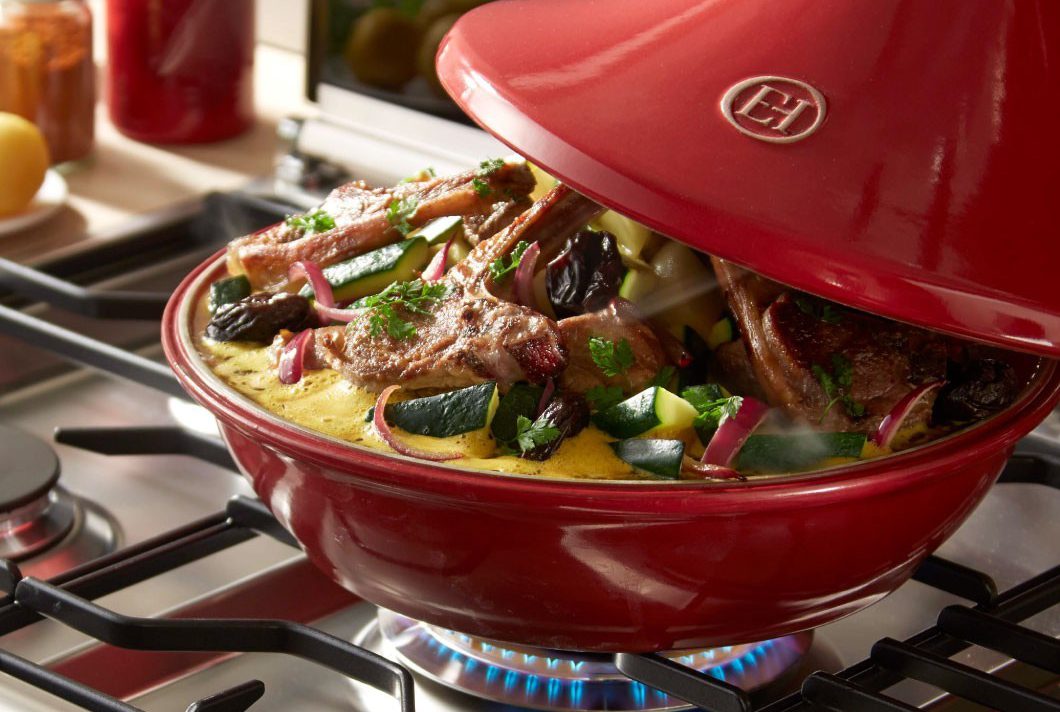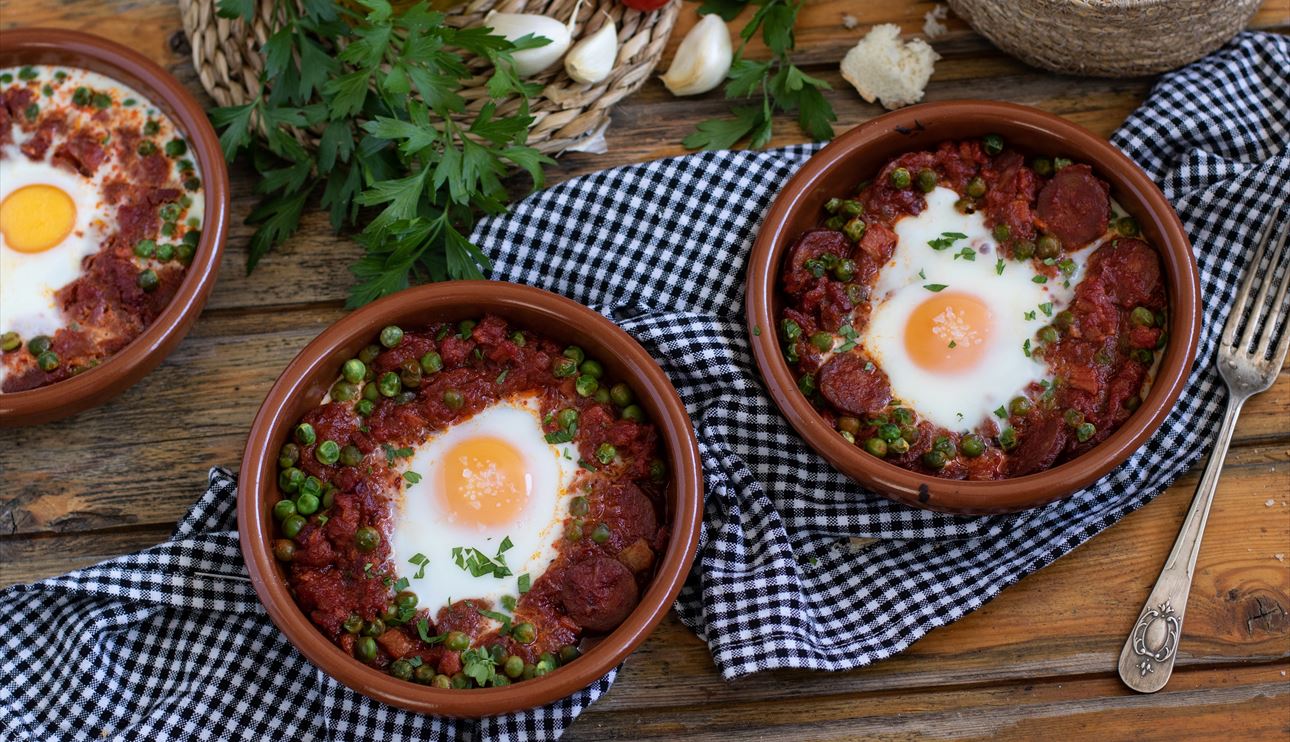The culinary experience is a fundamental element of our tours and is one of the reasons we are so excited by our Conquest of the Moors Cycling tour . On our Epic cycling tours, we travel through multiple regions, experiencing the very best of each locale. Eating on tour not only refuels us but gives us a true sense of place as you travel to each special region of a country. Our routes are primarily steered towards riding the most picturesque, quiet roads, but often we also route plan to experience a particularly wonderful dish, wine, or restaurant.
With this in mind, we give you three delicious recipes, chosen to represent some of the incredible yet distinct cuisines of three special countries that feature on this tour – Morocco, Spain, and Portugal.
Morocco- Fruity lamb tagine (serves 4)
What trip to Morocco is complete without a tagine? Subtle in flavour and so satisfying, this dish can be used anywhere from on a weeknight to a dinner party. We have also frozen excess quantities of this dish and confirm that is freezes well for those who like to prepare ahead.
For those who prefer a vegetarian option, we have also made this dish without the lamb but added chunks of potato and zucchini (courgette). It was just as delicious.
Ingredients
2 tbsp Spain- Andalusian Huevos a la Flamenca (serves 4)
This specialty is from Seville and would make an excellent breakfast or lunch. Add some fresh bread (gluten-free if desired) and a green salad to make it a meal. For vegetarians, omit the ham and chorizo.
Ingredients
4 tablespoons olive oil
100 grams serrano ham, chopped
1 small onion, chopped
1 clove garlic, chopped
3 tomatoes (about 750 grams), peeled and chopped
8 eggs
slices of chorizo sausage (gluten free if coeliac or intolerant)
cooked peas
cooked asparagus tips or a few cooked green beans
strips of tinned red pimiento
salt and pepper
chopped parsley
Method
In a frying pan heat the oil and add the chopped ham, onion and garlic. Sauté a few minutes, then add the tomatoes.
Continue cooking on medium heat until tomatoes are very reduced, about 15 minutes.
Oil four (or eight) oven-proof ramekins and divide the tomato sauce between them. Break one or two eggs into each ramekin. Put chorizo slices around the eggs and sprinkle on a few cooked peas, asparagus or beans.
Criss-cross the eggs with strips of pimiento. Sprinkle with salt and pepper and chopped parsley. Put in a hot oven (200ºC) until whites are set but yolks still liquid, about 8 minutes.
Portugal- Pastéis de Nata (makes around 40)
If you have ever been to Portugal, the chances are that you have tried the traditional custard tarts, named Pastéis de Nata. These incredible little custard tarts are so delicious they will not last long. If you would like to cheat a little, you could use pre-prepared puff pastry and start at step 4 in the method for preparing the pastry.
Ingredients For the pasteis de nata dough
2 cups minus 2 tablespoons 1ll-purpose flour, plus additional for the work surface
1/3 teaspoon sea salt
3/4 cup plus 2 tablespoons cold water 225 grams (8 oz) unsalted butter, room temperature, stirred until smooth
For the custard
3 tablespoons all-purpose flour 1 1/3 cups granulated sugar 1 1/4 cups milk, divided 1 cinnamon stick 2/3 cup water 1/2 teaspoon vanilla extract 6 large egg yolks, whisked
For the garnish
Icing sugar (confectioners’ sugar)
Cinamon
Method
For the pastry
In a stand mixer fitted with a dough hook, mix the flour, salt, and water until a soft, pillowy dough forms that pulls away from the side of the bowl, about 30 seconds.
Generously flour a work surface and pat the dough into a 6-inch square using a pastry scraper. Flour the dough, cover with plastic wrap, and let it rest at room temperature for 15 minutes.
Roll the dough into an 18-inch square. As you work, use the scraper to lift the dough to make sure the underside isn’t sticking to your work surface.
Brush the excess flour off the top of the dough, trim any uneven edges, and, using a small offset spatula, dot and then spread the left 2/3 portion of the dough with a little less than 1/3 of the butter being careful to leave a 1-inch plain border around the edge of the dough.
Turn the dough 90° to the left so the fold is facing you. Lift the dough and flour the work surface. Once again roll it out to an 18-inch square, then dot the left 2/3 of the dough with 1/3 of the butter and smear it over the dough. Fold the dough as directed in steps 4 and 5.
Using the spatula as an aid, lift the edge of dough closest to you and roll the dough away from you into a tight log, brushing the excess flour from the underside as you go. Trim the ends and cut the log in half. Wrap each piece in plastic wrap and chill for 2 hours or preferably overnight. (The pastry can be frozen for up to 3 months.)
Make the custard
In a medium bowl, whisk the flour and 1/4 cup milk until smooth.
Bring the sugar, cinnamon, and water to a boil in a small saucepan and cook until an instant-read thermometer registers 220°F (100°C). Do not stir.
Meanwhile, in another small saucepan, scald the remaining 1 cup milk. Whisk the hot milk into the flour mixture.
Remove the cinnamon stick and then pour the sugar syrup in a thin stream into the hot milk-and-flour mixture, whisking briskly. Add the vanilla and stir for a minute until very warm but not hot. Whisk in the yolks, strain the mixture into a bowl, cover with plastic wrap, and set aside. The custard will be thin; that is as it should be. (You can refrigerate the custard for up to 3 days.)
Assemble and bake the pastries
Place an oven rack in the top third position and heat the oven to 550°F (290°C). Remove a pastry log from the refrigerator and roll it back and forth on a lightly floured surface until it’s about an inch in diameter and 16 inches long. Cut it into scant 3/4-inch pieces. Place 1 piece pastry dough, cut side down, in each well of a nonstick 12-cup mini-muffin pan (2-by-5/8-inch size). If using classic tins, cut the dough into generous 1-inch pieces. Allow the dough pieces to soften several minutes until pliable.
Have a small cup of water nearby. Dip your thumbs in the water, then straight down into the middle of the dough spiral. Flatten it against the bottom of the cup to a thickness of about 1/16 inch, then smooth the dough up the sides and create a raised lip about 1/8 inch above the pan. The pastry bottoms should be thinner than the tops.
Fill each cup 3/4 full with the cool custard. Bake the pastries until the edges of the dough are frilled and brown, about 8 to 9 minutes for the mini-muffin tins, 15 to 17 minutes for the classic tins. Remove from the oven and allow the pasteis to cool a few minutes in the pan, then transfer to a rack and cool until just warm.
Sprinkle the pasteis generously with confectioners’ sugar, then cinnamon and serve. Repeat with the remaining pastry and custard. They taste best when are eaten the same day.
Bon Appetit. Leave us a comment or send us a photo of your creations with the hashtag #rideandseekers



